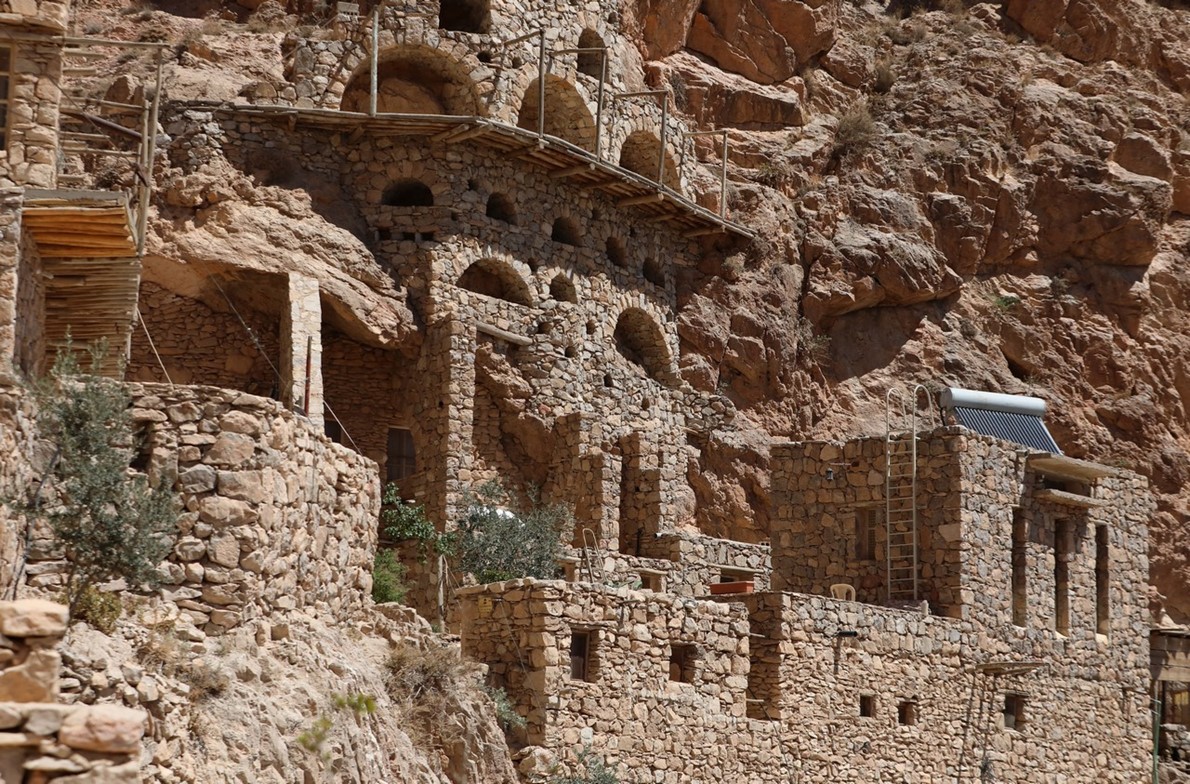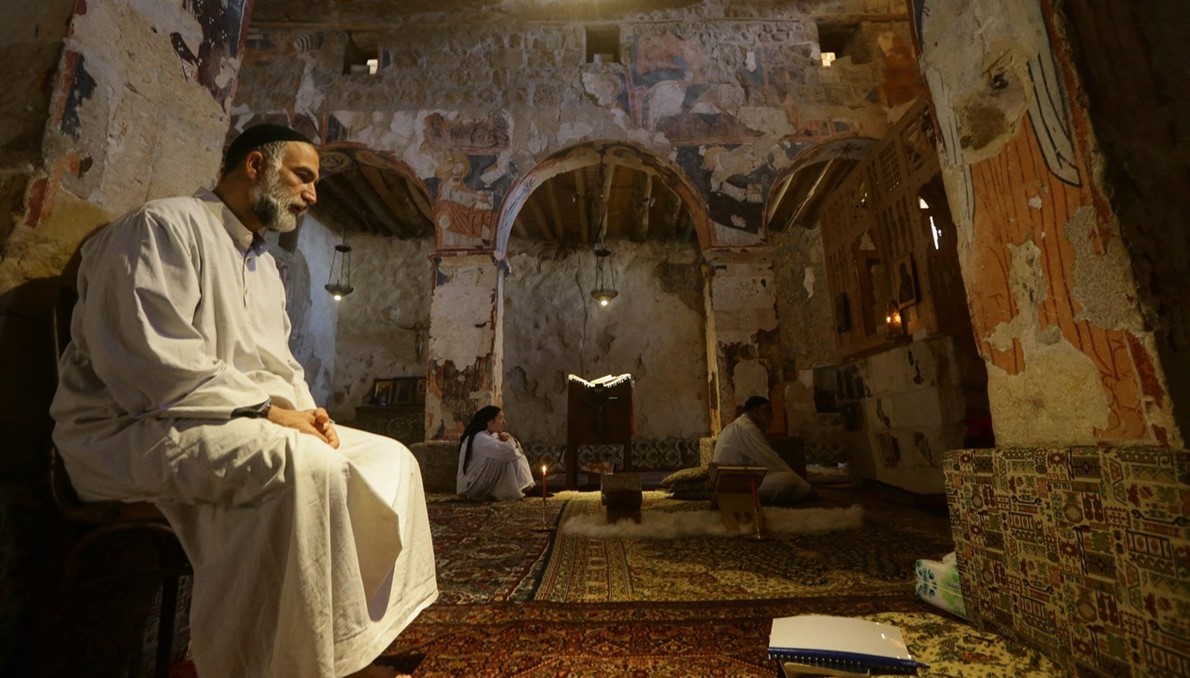NABK, Syria — A
Syrian desert monastery that was
once a hub for interfaith dialogue, attracting tens of thousands, has reopened
to visitors after more than a decade of war and isolation.
اضافة اعلان
“We yearn for
people to return. We want to see them pray and meditate with us once more, so
that they may find here a space for calm, silence and contemplation,” Father
Jihad Youssef told AFP, his voice echoing through the dark, empty halls of the
monastery he heads.
In 2010, 30,000
people visited Deir Mar Moussa Al-Habashi (St Moses the Ethiopian), a 7th
century monastery perched atop a barren, rocky hill about 100km north of
Damascus.
But the onset of
civil war in 2011 and the disappearance of Father Paolo Dall’Oglio, who had led
and revived the community since 1982, scared away visitors for nearly a decade.
 A view of Deir Mar Moussa Al-Habashi (St Moses the Ethiopian monastery), one of the ancient monasteries in Syria in the mountains near the desert in the Nabk area in Damascus countryside, on June 11, 2022.
A view of Deir Mar Moussa Al-Habashi (St Moses the Ethiopian monastery), one of the ancient monasteries in Syria in the mountains near the desert in the Nabk area in Damascus countryside, on June 11, 2022.
With security
having improved in surrounding areas, the monastery reopened its doors to
visitors this month.
They must climb
300 steps to reach the stone monastery, built on the ruins of a Roman tower and
partly carved into the rock.
It has an 11th
century church adorned with icons, ancient murals and writing in Arabic ,Syriac, and
Greek that says “God is love” and “in the name of God, the
Compassionate, the Merciful” — a phrase that serves as Muslim praise to God.
Symbol of
coexistence
Dall’Oglio hosted interfaith seminars at the monastery, where the
Christian minority and Muslims used to pray side by side, turning it into a
symbol of coexistence that attracted visitors and worshippers for three
decades.
The Italian
Jesuit priest was expelled from Syria in 2012 for supporting a mass
anti-government uprising, but returned a year later.
He disappeared
in the summer of 2013, on his way to the headquarters of the group that later
became known as
Daesh in the city of Raqqa, where he had gone to plead for the
release of kidnapped activists.
Dall’Oglio’s
practice of inter-religious coexistence was the exact opposite of the
intolerant, murderous extremism of Daesh.
I started looking for ways to fill these long hours ... because sometimes we had zero yearly visitors
He was reported
to have been executed and his body dumped in a crevice soon after his capture,
but his death was never confirmed by any party.
“IS (Daesh) most
likely kidnapped him. We do not know for sure whether he is alive or dead,”
Youssef said, adding that no one contacted the monastery to demand ransom.
An escape
In 2015, the monastery came under Daesh gunfire after the
Islamist extremist began two years of control in the nearby Homs countryside.
“We were scared
we would be kidnapped or killed at any moment,” especially after Daesh reached
the nearby village of Al-Qaryatain and kidnapped groups of Christians there,
Youssef said.
Daesh abducted
the monastery’s former chief Jacques Mourad from Al-Qaryatain for several
months in 2015.
The group razed
a monastery in the nearby village and locked hundreds of Christians in a
dungeon. They were later freed, but a
Christian community which once numbered
hundreds in Al-Qaryatain has now fallen to fewer than two dozen.
 Father Jihad Youssef at Deir Mar Moussa Al-Habashi (St Moses the
Ethiopian monastery), one of the ancient monasteries in Syria in the mountains
near the desert in the Nabek area in Damascus countryside, on June 11, 2022.
Father Jihad Youssef at Deir Mar Moussa Al-Habashi (St Moses the
Ethiopian monastery), one of the ancient monasteries in Syria in the mountains
near the desert in the Nabek area in Damascus countryside, on June 11, 2022.
“We experienced
all kinds of fear,” Youssef said, adding that they felt isolated in the desert
monastery at the height of the fighting, and later because of the COVID-19
pandemic.
US-backed local
forces defeated Daesh in eastern Syria three years ago, while Syrian government
troops, supported by
Russia and
Iran-linked forces, have recaptured much
territory from rebels.
“This is a
simple monastery devoid of luxuries. There is no internet or cell coverage,
making it easier to escape the hustle and bustle of the city,” Youssef said.
Two monks, a
nun, and two postulants live in the three-story monastery, which includes rooms
for visitors, a bird farm, and an expansive library.
They live off
the land and drink from a nearby well.
In the early
hours of the morning, Youssef calls out to them for breakfast from a courtyard
overlooking caves carved into the hill.
The lonely
hilltop refuge basks in unparalleled tranquility.
Youssef
Al-Halabi, 48, has been a monk for 16 years but he said the lack of visitors
left him wondering what he could do to fill his spare time.
“I started
looking for ways to fill these long hours ... because sometimes we had zero
yearly visitors,” he said.
After his
morning prayer, the white-bearded monk usually heads to a nearby cave to make
candles. Sometimes he occupies himself with farming.
Halabi, who has
devoted his life to worship and to serving visitors, said he hoped people would
fill the monastery once more “to share our way of life”.
“This is a space to
breathe, away from the noise and agitation,” he said.
Read more Trending
Jordan News



